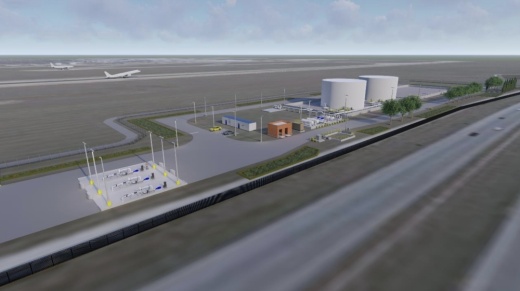With a 5-5 vote, City Council shot down a measure from District 2 Council Member Vanessa Fuentes that would have halted the airport's plans for an expanded fuel storage complex and started a new search for alternative sites. The resolution from Fuentes would have also required additional environmental reviews and community engagement for the project, which officials have said is an essential piece of long-term expansion plans to support the airport's—and region's—rapid growth.
Fuentes and council members Kathie Tovo, Pio Renteria, Ann Kitchen and Chito Vela voted for the resolution, while Mayor Steve Adler and council members Alison Alter, Paige Ellis, Leslie Pool and Mackenzie Kelly voted against.
Airing concerns
While plans to bring several new fuel tanks to the airport's western edge were finalized years ago, an effort to step back and reevaluate the project was led in recent months by Fuentes, community activists and environmental groups, and East Austin residents including airport neighbors. The April vote came after council heard dozens of comments from those generally opposed to the plan and took up an extended discussion on the merits of Fuentes' proposal.
Concerns from the community centered on a lack of notification or opportunity for engagement about the proposal during its development as well as potential health and safety risks associated with a new fuel tank farm. That topic also echoed the community-led effort of the 1990s to shutter a toxic tank farm at Airport Boulevard and Springdale Road that contaminated the surrounding area and affected the health of area residents.
"We don’t want to see the harm come again to this particular community, because you start off with one tank, two tanks, three tanks, four tanks. That’s what’s proposed, and as the airport grows, so will the tank farm," said Suzana Almanza, executive director of People Organized in Defense of Earth and Her Resources.
Speaking to community complaints that the project furthers environmental racism on the east side, neighborhood representative Daniel Llanes said the city's plans represent "two steps forward, one step back." And resident Rocio Villalobos said the project's environmental reviews did not properly consider how it might affect neighboring homes and businesses, many of which are located just several hundred feet from the proposed tanks.
"How can an environmental impact assessment that’s measuring impact in areas like culture and environmental justice be determined without any public participation? I wonder if there would still be ‘no significant impact’ if the community was a little bit wealthier, a little bit whiter, a little more fluent in English?" she said.
Opponents of the item included representatives from the Greater Austin Chamber of Commerce and a consortium of several airlines—which together manage the airport's fuel facilities.
Fuel planning continues
As consideration of the measure to pause the project moved along, council discussion and questioning of aviation department CEO Jacqueline Yaft shed more light on strained conditions at AUS and the outlook for an airport that is consistently short on jet fuel.
Yaft said as little as one to three days of fuel supply are on hand at AUS at any given time, well below an industry standard of five to seven days. If storage capacity is not expanded as planned, Yaft said, airlines could also face logistical struggles and 80-plus flights could be forced to fly into town with extra fuel every day,
Finding a new home for the tank farm could also delay the airport's overall expansion plans. Given previous approvals, construction of the current fuel project could take less than two years. If plans were scrapped, she said a new round of reviews and development could leave the project on a timeline of four years or more to build.
Fuentes noted that more jet fuel capacity is needed at Austin's airport. However, she said her resolution represented a compromise that would improve existing facilities in the short term while pulling back on a larger project and acknowledging previous missteps.
“I realize that expanding on the current site isn’t the most cost-effective strategy. But the reality here is that we’ve identified a process that has been flawed; that we are talking about a community that has been designated as an environmental justice community, which makes it so much more important for us to ensure that we do it right," she said. "It is very clear that this is about the human impact that this would have. Our community deserves a fair process.”
Despite the final vote outcome, Fuentes said she plans to bring additional proposals back to council that would require city officials to sign off on future airport expansion items—and allow for more public input. City Manager Spencer Cronk also said the city will explore the possibility of offering voluntary buyouts to residents near the planned fuel tanks.
Sam Haynes, public information officer with the city aviation department, said a start date and timeline for the fuel tank project have yet to be determined after the April 7 vote. Next steps will be laid out in coordination with the airline consortium and with updates for the public, Haynes said.
"Understanding our community’s legacy of environmental injustice in East Austin is crucial to making equitable and sound decisions for today and the future," the aviation department said in a statement. "We also recognize the importance of investing in community relationships and providing timely information to the public. We look forward to launching our Airport Green Team, which will guide our environmental stewardship through continued engagement with the community as we work to modernize the airport and build the infrastructure needed to support our growing city."





